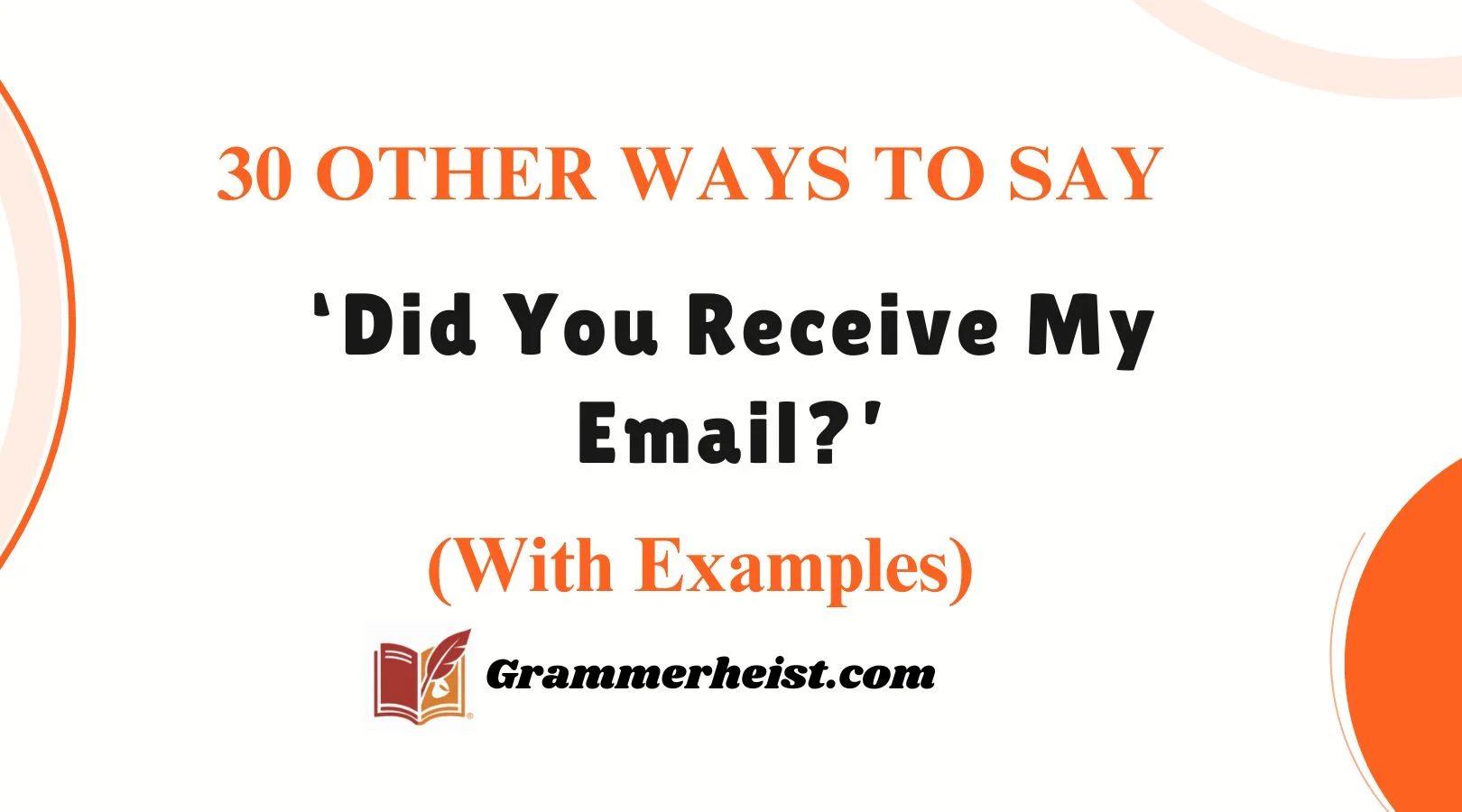Finding the right words to check in about an email can make all the difference in how you’re perceived. A thoughtful message conveys professionalism, warmth, and care, creating a stronger connection with the recipient.
This guide offers 30 meaningful alternatives to asking if someone received your email. With examples and insights, you’ll discover ways to communicate that feel personal, polite, and effective.
What Does “Did You Receive My Email?” Mean?
“Did you receive my email?” is a direct way to inquire if someone saw your message. It’s often used to confirm delivery or prompt a response. While functional, it can sometimes come across as abrupt or impatient, depending on the tone. Using alternative phrasing can help convey your message with warmth, professionalism, or urgency as needed.
Is It Professional/Polite to Say “Did You Receive My Email?”
Yes, it’s professional to use this phrase, but its tone and context matter. Politeness depends on how you word and deliver the question. If overused, it might feel repetitive or transactional. Opting for alternative phrasing shows effort and can make interactions more engaging and positive.
Advantages and Disadvantages of Using Alternatives
Advantages:
- Builds Rapport: Adds a personal touch to your communication.
- Avoids Redundancy: Keeps your messages fresh and engaging.
- Tone Variety: Allows customization to suit formal, casual, or urgent needs.
Disadvantages:
- Potential Over-Complexity: Some alternatives might feel wordy or unclear if not tailored to the situation.
- Risk of Misinterpretation: A casual tone might not always suit the professional context
Did You Receive My Email Synonyms:
- Just Following Up on My Email
- Did My Email Reach You?
- I Hope You Saw My Previous Email
- Can You Confirm You Received My Email?
- I’m Circling Back on My Email
- I wanted to Check If You Got My Message
- I’m Touching Base About My Email
- I’d Appreciate a Quick Reply to My Email
- Has My Email Reached You Yet?
- Checking In About My Earlier Email
- I’m Eager to Hear Back on My Email
- Have You Had a Chance to Review My Email?
- I Hope My Email Didn’t Get Missed
- I Just Wanted to Make Sure You Saw My Email
- When You Have a Moment, Could You Confirm My Email?
- Following Up to See If My Email Was Received
- I Hope You’ve Had Time to Look Over My Email
- Can You Let Me Know If My Email Came Through?
- Have You Seen My Email Yet?
- Wanted to Double-Check You Got My Email
- I Hope My Email Found You Well
- Can You Please Verify Receipt of My Email?
- Just a Reminder About My Email
- I’m hoping for a Response to My Email Soon
- I’d Like to Ensure My Email Was Delivered
- Did My Email Make It to Your Inbox?
- I Hope My Email Didn’t End Up in Spam
- Let Me Know If My Email Was Successfully Delivered
- I’m Wondering If My Email Reached You Safely
- Is There Any Update Based on My Email?
1. Just Following Up on My Email
Meaning: A polite way to inquire about the status of an email.
Definition: Suggest a friendly reminder while maintaining professionalism.
Detailed Explanation: Implies that the sender is being proactive without sounding impatient.
Scenario Examples:
“Hi [Name], I’m just following up on my email from earlier this week. Let me know if you need any additional details!”
Best Use: Use in formal or semi-formal settings to gently remind someone about a pending response.
Tone: Friendly and professional.
2. Did My Email Reach You?
Meaning: A straightforward way to confirm email delivery.
Definition: Seeks acknowledgment of receipt.
Detailed Explanation: Keeps the message concise but leaves room for interpretation as polite or urgent.
Scenario Examples:
“Hello [Name], I just wanted to ask—did my email from Monday reach you?”
Best Use: Suitable for both formal and informal emails.
Tone: Neutral but direct.
3. I Hope You Saw My Previous Email
Meaning: A warm acknowledgment of a potential oversight.
Definition: Hints at the importance of the previous email without being forceful.
Detailed Explanation: Creates an empathetic approach by considering that the recipient might be busy.
Scenario Examples:
“Hi [Name], I hope you saw my previous email about [subject]. I’m happy to clarify anything!”
Best Use: Perfect for light follow-ups with colleagues or clients.
Tone: Polite and empathetic.
4. Can You Confirm You Received My Email?
Meaning: Directly asks for acknowledgment of an email.
Definition: A polite and formal way to ensure the recipient has seen the message.
Detailed Explanation: This phrase is helpful when clarity and confirmation are your main goals.
Scenario Examples:
“Hello [Name], I just wanted to check—can you confirm you received my email regarding [topic]?”
Best Use: Ideal for professional settings, especially when working on deadlines.
Tone: Formal and straightforward.
5. I’m Circling Back on My Email
Meaning: Indicates a second attempt to revisit a topic or query from an earlier email.
Definition: Often used to remind the recipient without sounding impatient.
Detailed Explanation: Suggests persistence with a gentle and non-intrusive tone.
Scenario Examples:
“Hi [Name], I’m circling back on my email about [topic]. Please let me know if you need additional info.”
Best Use: Great for ongoing projects or when discussing deliverables.
Tone: Friendly and professional.
6. I Wanted to Check If You Got My Message
Meaning: A casual way to confirm the receipt of an email.
Definition: Frames the inquiry as a simple follow-up.
Detailed Explanation: Shows consideration without emphasizing urgency.
Scenario Examples:
“Hey [Name], I wanted to check if you got my message from last week about [subject].”
Best Use: Appropriate for informal work environments or personal connections.
Tone: Relaxed and conversational.
7. I’m Touching Base About My Email
Meaning: Suggest checking in regarding an earlier email.
Definition: A casual yet professional way to reopen communication.
Detailed Explanation: Balances formality with a friendly approach, suitable for most situations.
Scenario Examples:
“Hi [Name], I’m touching base about my email on [date]. Let me know if you need further details.”
Best Use: Perfect for routine follow-ups with team members or clients.
Tone: Neutral to warm.
8. I’d Appreciate a Quick Reply to My Email
Meaning: Politely emphasizes the need for a prompt response.
Definition: Indicates urgency while maintaining courtesy.
Detailed Explanation: Works well when deadlines or time-sensitive matters are involved.
Scenario Examples:
“Hello [Name], I’d appreciate a quick reply to my email regarding [topic] so we can proceed.”
Best Use: When time constraints require an immediate response.
Tone: Polite but firm.
9. Has My Email Reached You Yet?
Meaning: A casual inquiry about email delivery.
Definition: Poses the question in a way that assumes potential delays or issues.
Detailed Explanation: Implies that the sender is patient and open to resolving communication gaps.
Scenario Examples:
“Hi [Name], has my email about [topic] reached you yet? Just checking in.”
Best Use: Informal contexts or when working with someone who may have a busy schedule.
Tone: Casual and understanding.
10. Checking In About My Earlier Email
Meaning: Serves as a polite reminder for a prior email.
Definition: Suggests a status update without pressing too hard.
Detailed Explanation: Useful when you want to remain neutral and avoid pushing urgency.
Scenario Examples:
“Hello [Name], just checking in about my earlier email regarding [subject]. Let me know your thoughts when you can.”
Best Use: Midway between casual and formal communication styles.
Tone: Polite and considerate.
11. I’m Eager to Hear Back on My Email
Meaning: Expresses enthusiasm for a response.
Definition: Communicates excitement and interest without being overbearing.
Detailed Explanation: This phrase works well in creative or collaborative contexts.
Scenario Examples:
“Hi [Name], I’m eager to hear back on my email about [topic] and start moving forward.”
Best Use: Use when working on exciting projects or opportunities.
Tone: Positive and enthusiastic.
12. Have You Had a Chance to Review My Email?
Meaning: Indicates that you are patiently waiting for the recipient to read your message.
Definition: Frames the inquiry as empathetic to the recipient’s possible workload.
Detailed Explanation: Acknowledges that the recipient may need time, fostering goodwill.
Scenario Examples:
“Hi [Name], have you had a chance to review my email regarding [subject]? I’m happy to discuss further if needed.”
Best Use: Professional contexts requiring patience.
Tone: Empathetic and patient.
13. I Hope My Email Didn’t Get Missed
Meaning: A gentle nudge to ensure the recipient notices your email.
Definition: Assumes good intent, implying the message might have been overlooked.
Detailed Explanation: Offers a considerate tone, acknowledging the recipient’s possible busy schedule.
Scenario Examples:
“Hi [Name], I hope my email about [topic] didn’t get missed. Please let me know if you’d like me to resend it.”
Best Use: When following up after a few days without a reply.
Tone: Friendly and understanding.
14. I Just Wanted to Make Sure You Saw My Email
Meaning: Expresses concern that your previous email might not have been noticed.
Definition: Highlights the importance of the prior message without sounding demanding.
Detailed Explanation: Keeps the conversation light while reiterating your message’s significance.
Scenario Examples:
“Hello [Name], I just wanted to make sure you saw my email regarding [topic]. Let me know if you have any updates!”
Best Use: Ideal for casual follow-ups in semi-formal communication.
Tone: Polite and neutral.
Read More: Other Ways to Say ‘This Is Because’ (With Examples)
15. When You Have a Moment, Could You Confirm My Email?
Meaning: Requests acknowledgment of an email at the recipient’s convenience.
Definition: Emphasizes respect for the recipient’s time.
Detailed Explanation: Demonstrates patience and politeness, perfect for non-urgent matters.
Scenario Examples:
“Hi [Name], when you have a moment, could you confirm if you’ve received my email? Thanks!”
Best Use: When time isn’t critical, but confirmation is needed.
Tone: Patient and respectful.
16. Following Up to See If My Email Was Received
Meaning: A neutral inquiry to confirm email receipt.
Definition: Direct yet non-pressuring, making it suitable for most contexts.
Detailed Explanation: A versatile phrase that fits both formal and informal emails.
Scenario Examples:
“Hello [Name], I’m following up to see if my email from [date] was received. Let me know if you need further details.”
Best Use: Appropriate for all professional or semi-formal interactions.
Tone: Neutral and polite.
17. I Hope You’ve Had Time to Look Over My Email
Meaning: Expresses understanding about the recipient’s possible delay in responding.
Definition: Combines politeness with a light prompt for action.
Detailed Explanation: Works well to maintain goodwill while gently seeking attention to your email.
Scenario Examples:
“Hi [Name], I hope you’ve had time to look over my email about [topic]. Let me know if you have any questions!”
Best Use: Best for polite reminders when responses are pending.
Tone: Empathetic and encouraging.
18. Can You Let Me Know If My Email Came Through?
Meaning: Asks for confirmation that the email reached its destination.
Definition: Suggests that technical issues might have delayed the message.
Detailed Explanation: Assumes no fault but seeks verification for peace of mind.
Scenario Examples:
“Hi [Name], could you let me know if my email regarding [topic] came through? Thanks in advance!”
Best Use: Great when concerned about email delivery issues.
Tone: Neutral and considerate.
19. Have You Seen My Email Yet?
Meaning: A casual way to ask if an email was noticed.
Definition: Keeps the conversation informal and light.
Detailed Explanation: Perfect for colleagues or friends with whom you share a relaxed rapport.
Scenario Examples:
“Hey [Name], just wondering if you’ve seen my email about [topic] yet?”
Best Use: Informal and non-urgent scenarios.
Tone: Casual and friendly.
20. Wanted to Double-Check You Got My Email
Meaning: A friendly reminder to ensure email delivery.
Definition: Frames the follow-up as a secondary verification step.
Detailed Explanation: This phrase can feel natural and conversational in various contexts.
Scenario Examples:
“Hi [Name], just wanted to double-check if you got my email about [topic]. Let me know if I should resend it!”
Best Use: Useful for casual professional or personal interactions.
Tone: Friendly and helpful.
21. I Hope My Email Found You Well
Meaning: Combines a polite greeting with a subtle inquiry about email receipt.
Definition: A warm, professional phrase to start a follow-up conversation.
Detailed Explanation: Sets a positive tone and shows care for the recipient’s well-being while leading into the email query.
Scenario Examples:
“Hello [Name], I hope my email found you well. I’m following up to check if you’ve had a chance to review it.”
Best Use: Best for formal settings or when addressing someone you don’t frequently contact.
Tone: Polite and cordial.
22. Can You Please Verify Receipt of My Email?
Meaning: A formal request for acknowledgment of an email.
Definition: Direct yet polite, making it clear you need confirmation.
Detailed Explanation: This phrase is ideal for instances where email confirmation is critical.
Scenario Examples:
“Hi [Name], can you please verify receipt of my email regarding [topic]? Looking forward to your reply.”
Best Use: Use in professional or legal communications where clarity is key.
Tone: Formal and respectful.
23. Just a Reminder About My Email
Meaning: A gentle nudge to recall your earlier communication.
Definition: Positions the follow-up as a simple prompt rather than a demand.
Detailed Explanation: Helps maintain a positive tone while ensuring the email is brought back into focus.
Scenario Examples:
“Hi [Name], just a quick reminder about my email from [date] regarding [topic]. Let me know if you need more information!”
Best Use: Perfect for friendly reminders in professional or semi-formal exchanges.
Tone: Polite and approachable.
24. I’m hoping for a Response to My Email Soon
Meaning: Indicates you are looking forward to a reply while showing understanding.
Definition: Adds a touch of urgency without sounding forceful.
Detailed Explanation: This phrase is helpful when timelines are involved but you want to maintain goodwill.
Scenario Examples:
“Hello [Name], I’m hoping for a response to my email about [topic] soon. Please let me know if there’s any issue.”
Best Use: Best for semi-urgent follow-ups that need action.
Tone: Professional and optimistic.
25. I’d Like to Ensure My Email Was Delivered
Meaning: A formal phrase that politely asks for confirmation of delivery.
Definition: Keeps the conversation professional while expressing your intent clearly.
Detailed Explanation: Assumes a neutral stance and focuses on technical delivery rather than urgency.
Scenario Examples:
“Hi [Name], I’d like to ensure my email regarding [topic] was delivered successfully. Let me know if you’ve received it.”
Best Use: When addressing delivery or spam concerns in professional settings.
Tone: Neutral and courteous.
26. Did My Email Make It to Your Inbox?
Meaning: A casual inquiry about whether the email reached its destination.
Definition: Frames the question as a technical check rather than a critique.
Detailed Explanation: Keeps the tone light while seeking clarification.
Scenario Examples:
“Hi [Name], I just wanted to check—did my email about [topic] make it to your inbox?”
Best Use: Ideal for casual or informal professional relationships.
Tone: Friendly and conversational.
27. I Hope My Email Didn’t End Up in Spam
Meaning: Suggest the possibility that your email might have been mistakenly flagged.
Definition: A friendly and humorous way to follow up while addressing potential delivery issues.
Detailed Explanation: Helps diffuse awkwardness in situations where the recipient hasn’t responded yet.
Scenario Examples:
“Hello [Name], I hope my email about [topic] didn’t end up in spam! Please let me know if you’ve seen it.”
Best Use: Use when you suspect delivery issues or want to keep the tone light.
Tone: Playful yet professional.
28. Let Me Know If My Email Was Successfully Delivered
Meaning: A straightforward request to confirm email receipt.
Definition: Makes it clear that your concern lies with the technical delivery.
Detailed Explanation: This avoids any sense of urgency or criticism, making it suitable for formal contexts.
Scenario Examples:
“Hi [Name], could you let me know if my email about [topic] was successfully delivered? Thanks!”
Best Use: When communication may have technical barriers.
Tone: Neutral and factual.
29. I’m Wondering If My Email Reached You Safely
Meaning: A kind and empathetic way to ask if an email was received.
Definition: Adds a touch of warmth to the follow-up.
Detailed Explanation: Positions the follow-up as a concern for delivery rather than a critique of response time.
Scenario Examples:
“Hi [Name], I’m wondering if my email about [topic] reached you safely. Let me know if you’d like me to resend it.”
Best Use: Suitable for building rapport with clients or colleagues.
Tone: Empathetic and caring.
30. Is There Any Update Based on My Email?
Meaning: Gently asks for a status update related to the email.
Definition: Encourages the recipient to take action without applying pressure.
Detailed Explanation: Keeps the conversation action-oriented while allowing for flexibility in the timeline.
Scenario Examples:
“Hello [Name], is there any update based on my email from [date]? Let me know how I can assist!”
Best Use: When you’re following up on ongoing discussions or projects.
Tone: Polite and proactive.
Conclusion
Using thoughtful alternatives to “Did you receive my email?” shows your consideration for the recipient’s time, workload, and communication preferences. These 30 examples empower you to craft messages that are not only professional but also empathetic, ensuring your follow-ups are received positively.
By adapting your tone and phrasing to suit the context, you can build stronger relationships and foster better communication—one email at a time.

Leo Scott is a passionate writer and editor with a keen eye for detail and a deep love for language. With years of experience in the world of grammar and communication, Leo is dedicated to helping individuals and businesses improve their written content.



